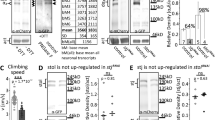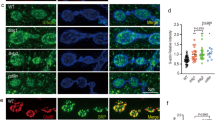Abstract
Synaptogenesis involves the transformation of a growth cone into synaptic boutons specialized for transmitter release. In Drosophila embryos lacking the α2δ-3 subunit of presynaptic, voltage-dependent Ca2+ channels, we found that motor neuron terminals failed to develop synaptic boutons and cytoskeletal abnormalities arose, including the loss of ankyrin2. Nevertheless, functional presynaptic specializations were present and apposed to clusters of postsynaptic glutamate receptors. The α2δ-3 protein has been thought to function strictly as an auxiliary subunit of the Ca2+ channel, but the phenotype of α2δ-3 (also known as stj) mutations cannot be explained by a channel defect; embryos lacking the pore-forming α1 subunit cacophony formed boutons. The synaptogenic function of α2δ-3 required only the α2 peptide, whose expression sufficed to rescue bouton formation. Our results indicate that α2δ proteins have functions that are independent of their roles in the biophysics and localization of Ca2+ channels and that synaptic architecture depends on these functions.
This is a preview of subscription content, access via your institution
Access options
Subscribe to this journal
Receive 12 print issues and online access
$209.00 per year
only $17.42 per issue
Buy this article
- Purchase on Springer Link
- Instant access to full article PDF
Prices may be subject to local taxes which are calculated during checkout








Similar content being viewed by others
References
Lardi-Studler, B. & Fritschy, J.M. Matching of pre- and postsynaptic specializations during synaptogenesis. Neuroscientist 13, 115–126 (2007).
Robitaille, R., Adler, E.M. & Charlton, M.P. Strategic location of calcium channels at transmitter release sites of frog neuromuscular synapses. Neuron 5, 773–779 (1990).
Wolf, M., Eberhart, A., Glossmann, H., Striessnig, J. & Grigorieff, N. Visualization of the domain structure of an L-type Ca2+ channel using electron cryo-microscopy. J. Mol. Biol. 332, 171–182 (2003).
Nishimune, H., Sanes, J.R. & Carlson, S.S. A synaptic laminin-calcium channel interaction organizes active zones in motor nerve terminals. Nature 432, 580–587 (2004).
De Waard, M., Gurnett, C.A. & Campbell, K.P. Structural and functional diversity of voltage-activated calcium channels. Ion Channels 4, 41–87 (1996).
Arikkath, J. & Campbell, K.P. Auxiliary subunits: essential components of the voltage-gated calcium channel complex. Curr. Opin. Neurobiol. 13, 298–307 (2003).
Dolphin, A.C. Beta subunits of voltage-gated calcium channels. J. Bioenerg. Biomembr. 35, 599–620 (2003).
Littleton, J.T. & Ganetzky, B. Ion channels and synaptic organization: analysis of the Drosophila genome. Neuron 26, 35–43 (2000).
Qin, N., Yagel, S., Momplaisir, M.L., Codd, E.E. & D'Andrea, M.R. Molecular cloning and characterization of the human voltage-gated calcium channel alpha(2)delta-4 subunit. Mol. Pharmacol. 62, 485–496 (2002).
Klugbauer, N., Marais, E. & Hofmann, F. Calcium channel alpha2delta subunits: differential expression, function, and drug binding. J. Bioenerg. Biomembr. 35, 639–647 (2003).
Jay, S.D. et al. Structural characterization of the dihydropyridine-sensitive calcium channel alpha 2-subunit and the associated delta peptides. J. Biol. Chem. 266, 3287–3293 (1991).
Whittaker, C.A. & Hynes, R.O. Distribution and evolution of von Willebrand/integrin A domains: widely dispersed domains with roles in cell adhesion and elsewhere. Mol. Biol. Cell 13, 3369–3387 (2002).
Anantharaman, V. & Aravind, L. Cache—a signaling domain common to animal Ca2+-channel subunits and a class of prokaryotic chemotaxis receptors. Trends Biochem. Sci. 25, 535–537 (2000).
Gurnett, C.A., Felix, R. & Campbell, K.P. Extracellular interaction of the voltage-dependent Ca2+ channel alpha2delta and alpha1 subunits. J. Biol. Chem. 272, 18508–18512 (1997).
Cantí, C. et al. The metal-ion-dependent adhesion site in the Von Willebrand factor-A domain of alpha2delta subunits is key to trafficking voltage-gated Ca2+ channels. Proc. Natl. Acad. Sci. USA 102, 11230–11235 (2005).
Gurnett, C.A., De Waard, M. & Campbell, K.P. Dual function of the voltage-dependent Ca2+ channel alpha 2 delta subunit in current stimulation and subunit interaction. Neuron 16, 431–440 (1996).
Wiser, O. et al. The alpha 2/delta subunit of voltage sensitive Ca2+ channels is a single transmembrane extracellular protein which is involved in regulated secretion. FEBS Lett. 379, 15–20 (1996).
Felix, R. Molecular regulation of voltage-gated Ca2+ channels. J. Recept. Signal Transduct. Res. 25, 57–71 (2005).
Bernstein, G.M. & Jones, O.T. Kinetics of internalization and degradation of N-type voltage-gated calcium channels: role of the alpha(2)/delta subunit. Cell Calcium 41, 27–40 (2007).
Dickman, D.K., Kurshan, P.T. & Schwarz, T.L. Mutations in a Drosophila alpha2delta voltage-gated calcium channel subunit reveal a crucial synaptic function. J. Neurosci. 28, 31–38 (2008).
Dolphin, A.C. et al. The effect of alpha2-delta and other accessory subunits on expression and properties of the calcium channel alpha1G. J. Physiol. (Lond.) 519, 35–45 (1999).
Barclay, J. et al. Ducky mouse phenotype of epilepsy and ataxia is associated with mutations in the Cacna2d2 gene and decreased calcium channel current in cerebellar Purkinje cells. J. Neurosci. 21, 6095–6104 (2001).
Brodbeck, J. et al. The ducky mutation in Cacna2d2 results in altered Purkinje cell morphology and is associated with the expression of a truncated alpha 2 delta-2 protein with abnormal function. J. Biol. Chem. 277, 7684–7693 (2002).
Ly, C.V., Yao, C.K., Verstreken, P., Ohyama, T. & Bellen, H.J. straightjacket is required for the synaptic stabilization of cacophony, a voltage-gated calcium channel alpha1 subunit. J. Cell Biol. 181, 157–170 (2008).
Wycisk, K.A. et al. Structural and functional abnormalities of retinal ribbon synapses due to Cacna2d4 mutation. Invest. Ophthalmol. Vis. Sci. 47, 3523–3530 (2006).
Yoshihara, M., Rheuben, M.B. & Kidokoro, Y. Transition from growth cone to functional motor nerve terminal in Drosophila embryos. J. Neurosci. 17, 8408–8426 (1997).
Roos, J., Hummel, T., Ng, N., Klambt, C. & Davis, G.W. Drosophila Futsch regulates synaptic microtubule organization and is necessary for synaptic growth. Neuron 26, 371–382 (2000).
Pielage, J. et al. A presynaptic giant ankyrin stabilizes the NMJ through regulation of presynaptic microtubules and transsynaptic cell adhesion. Neuron 58, 195–209 (2008).
Koch, I. et al. Drosophila ankyrin 2 is required for synaptic stability. Neuron 58, 210–222 (2008).
Bennett, V. & Chen, L. Ankyrins and cellular targeting of diverse membrane proteins to physiological sites. Curr. Opin. Cell Biol. 13, 61–67 (2001).
Wagh, D.A. et al. Bruchpilot, a protein with homology to ELKS/CAST, is required for structural integrity and function of synaptic active zones in Drosophila. Neuron 49, 833–844 (2006).
Smith, L.A. et al. A Drosophila calcium channel alpha1 subunit gene maps to a genetic locus associated with behavioral and visual defects. J. Neurosci. 16, 7868–7879 (1996).
Kawasaki, F., Felling, R. & Ordway, R.W. A temperature-sensitive paralytic mutant defines a primary synaptic calcium channel in Drosophila. J. Neurosci. 20, 4885–4889 (2000).
Kawasaki, F., Zou, B., Xu, X. & Ordway, R.W. Active zone localization of presynaptic calcium channels encoded by the cacophony locus of Drosophila. J. Neurosci. 24, 282–285 (2004).
Rieckhof, G.E., Yoshihara, M., Guan, Z. & Littleton, J.T. Presynaptic N-type calcium channels regulate synaptic growth. J. Biol. Chem. 278, 41099–41108 (2003).
Kuromi, H., Honda, A. & Kidokoro, Y. Ca2+ influx through distinct routes controls exocytosis and endocytosis at Drosophila presynaptic terminals. Neuron 41, 101–111 (2004).
Hou, J., Tamura, T. & Kidokoro, Y. Delayed synaptic transmission in Drosophila cacophony null embryos. J. Neurophysiol. 100, 2833–2842 (2008).
Felix, R., Gurnett, C.A., De Waard, M. & Campbell, K.P. Dissection of functional domains of the voltage-dependent Ca2+ channel alpha2delta subunit. J. Neurosci. 17, 6884–6891 (1997).
Bangalore, R., Mehrke, G., Gingrich, K., Hofmann, F. & Kass, R.S. Influence of L-type Ca channel alpha 2/delta-subunit on ionic and gating current in transiently transfected HEK 293 cells. Am. J. Physiol. 270, H1521–H1528 (1996).
Shistik, E., Ivanina, T., Puri, T., Hosey, M. & Dascal, N. Ca2+ current enhancement by alpha 2/delta and beta subunits in Xenopus oocytes: contribution of changes in channel gating and alpha 1 protein level. J. Physiol. (Lond.) 489, 55–62 (1995).
Ruiz-Cañada, C. & Budnik, V. Introduction on the use of the Drosophila embryonic/larval neuromuscular junction as a model system to study synapse development and function, and a brief summary of pathfinding and target recognition. Int. Rev. Neurobiol. 75, 1–31 (2006).
Pack-Chung, E., Kurshan, P.T., Dickman, D.K. & Schwarz, T.L. A Drosophila kinesin required for synaptic bouton formation and synaptic vesicle transport. Nat. Neurosci. 10, 980–989 (2007).
Hortsch, M. et al. A conserved role for L1 as a transmembrane link between neuronal adhesion and membrane cytoskeleton assembly. Cell Adhes. Commun. 5, 61–73 (1998).
Bork, P. & Rohde, K. More von Willebrand factor type A domains? Sequence similarities with malaria thrombospondin-related anonymous protein, dihydropyridine-sensitive calcium channel and inter-alpha-trypsin inhibitor. Biochem. J. 279, 908–910 (1991).
Johansen, J., Halpern, M.E., Johansen, K.M. & Keshishian, H. Stereotypic morphology of glutamatergic synapses on identified muscle cells of Drosophila larvae. J. Neurosci. 9, 710–725 (1989).
Sink, H. & Whitington, P.M. Location and connectivity of abdominal motoneurons in the embryo and larva of Drosophila melanogaster. J. Neurobiol. 22, 298–311 (1991).
Vactor, D.V., Sink, H., Fambrough, D., Tsoo, R. & Goodman, C.S. Genes that control neuromuscular specificity in Drosophila. Cell 73, 1137–1153 (1993).
Stowers, R.S. & Schwarz, T.L. A genetic method for generating Drosophila eyes composed exclusively of mitotic clones of a single genotype. Genetics 152, 1631–1639 (1999).
Xu, T. & Rubin, G.M. Analysis of genetic mosaics in developing and adult Drosophila tissues. Development 117, 1223–1237 (1993).
Bischof, J., Maeda, R.K., Hediger, M., Karch, F. & Basler, K. An optimized transgenesis system for Drosophila using germline-specific phiC31 integrases. Proc. Natl. Acad. Sci. USA 104, 3312–3317 (2007).
Acknowledgements
We thank H. Kazama for assistance with the electrophysiology, R. Ordway, J.T. Littleton, L. Hall, H. Aberle, K. Basler and the Bloomington Stock Center for stocks and reagents, D. Featherstone, T. Littleton, N. Reese and A. Goldstein for helpful discussions, L. Bu and M. Liana of the MRDDRC Imaging and Histology Cores, the Harvard Medical School electron microscopy facility, and E. Pogoda for assistance. This work was supported by US National Institutes of Health grants RO1 NS041062 and MH075058 (T.L.S.) and a National Defense Science and Engineering Graduate Fellowship (P.T.K.).
Author information
Authors and Affiliations
Contributions
P.T.K. performed the experiments. A.O. designed and generated the HA-tagged α2δ-3 construct, collaborated in the design of experiments involving that construct and assisted with manuscript editing. P.T.K. and T.L.S. designed the experiments and wrote the paper.
Corresponding author
Supplementary information
Supplementary Text and Figures
Supplementary Figures 1–5 (PDF 944 kb)
Rights and permissions
About this article
Cite this article
Kurshan, P., Oztan, A. & Schwarz, T. Presynaptic α2δ-3 is required for synaptic morphogenesis independent of its Ca2+-channel functions. Nat Neurosci 12, 1415–1423 (2009). https://doi.org/10.1038/nn.2417
Received:
Accepted:
Published:
Issue Date:
DOI: https://doi.org/10.1038/nn.2417
This article is cited by
-
Training-induced circuit-specific excitatory synaptogenesis in mice is required for effort control
Nature Communications (2023)
-
New insights into glial scar formation after spinal cord injury
Cell and Tissue Research (2022)
-
Rab11-dependent recycling of calcium channels is mediated by auxiliary subunit α2δ-1 but not α2δ-3
Scientific Reports (2021)
-
Different functions of two putative Drosophila α2δ subunits in the same identified motoneurons
Scientific Reports (2020)
-
Neuronal α2δ proteins and brain disorders
Pflügers Archiv - European Journal of Physiology (2020)



